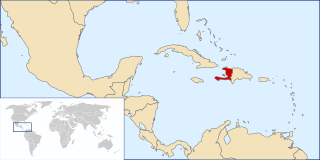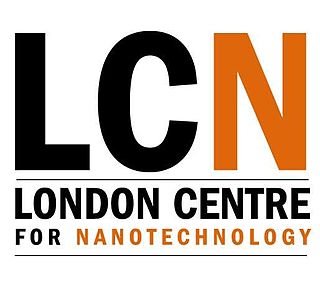Related Research Articles

Nanotechnology, often shortened to nanotech, is the use of matter on atomic, molecular, and supramolecular scales for industrial purposes. The earliest, widespread description of nanotechnology referred to the particular technological goal of precisely manipulating atoms and molecules for fabrication of macroscale products, also now referred to as molecular nanotechnology. A more generalized description of nanotechnology was subsequently established by the National Nanotechnology Initiative, which defined nanotechnology as the manipulation of matter with at least one dimension sized from 1 to 100 nanometers (nm). This definition reflects the fact that quantum mechanical effects are important at this quantum-realm scale, and so the definition shifted from a particular technological goal to a research category inclusive of all types of research and technologies that deal with the special properties of matter which occur below the given size threshold. It is therefore common to see the plural form "nanotechnologies" as well as "nanoscale technologies" to refer to the broad range of research and applications whose common trait is size.
A pidgin, or pidgin language, is a grammatically simplified means of communication that develops between two or more groups of people that do not have a language in common: typically, its vocabulary and grammar are limited and often drawn from several languages. It is most commonly employed in situations such as trade, or where both groups speak languages different from the language of the country in which they reside. Linguists do not typically consider pidgins as full or complete languages.

A creole language, or simply creole, is a stable natural language that develops from the process of different languages simplifying and mixing into a new form, and then that form expanding and elaborating into a full-fledged language with native speakers, all within a fairly brief period of time. While the concept is similar to that of a mixed or hybrid language, creoles are often characterized by a tendency to systematize their inherited grammar. Like any language, creoles are characterized by a consistent system of grammar, possess large stable vocabularies, and are acquired by children as their native language. These three features distinguish a creole language from a pidgin. Creolistics, or creology, is the study of creole languages and, as such, is a subfield of linguistics. Someone who engages in this study is called a creolist.
A lingua franca, also known as a bridge language, common language, trade language, auxiliary language, vehicular language, or link language, is a language systematically used to make communication possible between groups of people who do not share a native language or dialect, particularly when it is a third language that is distinct from both of the speakers' native languages.

Haitian Creole, commonly referred to as simply Creole, or Kreyòl in the Creole language, is a French-based creole language spoken by 10–12 million people worldwide, and is one of the two official languages of Haiti, where it is the native language of the vast majority of the population. Northern, Central, and Southern dialects are the three main dialects of Haitian Creole. The Northern dialect is predominantly spoken in Cap-Haïtien, Central is spoken in Port-au-Prince, and Southern in the Cayes area.

Big science is a term used by scientists and historians of science to describe a series of changes in science which occurred in industrial nations during and after World War II, as scientific progress increasingly came to rely on large-scale projects usually funded by national governments or groups of governments. Individual or small group efforts, or Small science, are still relevant today as theoretical results by individual authors may have a significant impact, but very often the empirical verification requires experiments using constructions, such as the Large Hadron Collider, costing between $5 and $10 billion.
Language contact occurs when speakers of two or more languages or varieties interact and influence each other. The study of language contact is called contact linguistics. When speakers of different languages interact closely, it is typical for their languages to influence each other. Language contact can occur at language borders, between adstratum languages, or as the result of migration, with an intrusive language acting as either a superstratum or a substratum.
A mixed language is a language that arises among a bilingual group combining aspects of two or more languages but not clearly deriving primarily from any single language. It differs from a creole or pidgin language in that, whereas creoles/pidgins arise where speakers of many languages acquire a common language, a mixed language typically arises in a population that is fluent in both of the source languages.

Peter Louis Galison is an American historian and philosopher of science. He is the Joseph Pellegrino University Professor in history of science and physics at Harvard University.
Australian Kriol is an English-based creole language that developed from a pidgin used initially in the region of Sydney and Newcastle in New South Wales, Australia, in the early days of European colonisation. Later, it was spoken by groups further west and north. The pidgin died out in most parts of the country, except in the Northern Territory, where the contact between European settlers, Chinese and other Asians and the Aboriginal Australians in the northern regions has maintained a vibrant use of the language, spoken by about 30,000 people. Despite its similarities to English in vocabulary, it has a distinct syntactic structure and grammar and is a language in its own right. It is distinct from Torres Strait Creole.
Earth systems engineering and management (ESEM) is a discipline used to analyze, design, engineer and manage complex environmental systems. It entails a wide range of subject areas including anthropology, engineering, environmental science, ethics and philosophy. At its core, ESEM looks to "rationally design and manage coupled human–natural systems in a highly integrated and ethical fashion". ESEM is a newly emerging area of study that has taken root at the University of Virginia, Cornell and other universities throughout the United States, and at the Centre for Earth Systems Engineering Research (CESER) at Newcastle University in the United Kingdom. Founders of the discipline are Braden Allenby and Michael Gorman.
Interactional expertise is part of a more complex classification of expertise developed by Harry Collins and Robert Evans. In this initial formulation interactional expertise was part of a threefold classification of substantive expertise that also included ‘no expertise’ and ‘contributory expertise’, by which they meant the expertise needed to contribute fully to all aspects of a domain of activity.
Nagamese is an Assamese-lexified creole language. Depending on location, ir has also been described and classified as an "extended pidgin" or "pidgincreole". Spoken natively by an estimated 30,000 people in the Indian northeastern state of Nagaland, it developed primarily as a means of marketplace and trade communication. Despite the official language of the state being English, Nagamese functions as a lingua franca and is spoken by nearly all Nagaland inhabitants. It is also used in mass media as well as in official state-regulated domains, including news and radio stations, education and political and governmental spheres. Nagamese is classified as a creole as, despite it being spoken as an "extended pidgin" by the majority of speakers across Nagaland, it is also spoken as the native mother tongue of the Dimasa community in Nagaland's largest city, Dimapur.
A post-creole continuum is a dialect continuum of varieties of a creole language between those most and least similar to the superstrate language. Due to social, political, and economic factors, a creole language can decreolize towards one of the languages from which it is descended, aligning its morphology, phonology, and syntax to the local standard of the dominant language but to different degrees depending on a speaker's status.

The London Centre for Nanotechnology is a multidisciplinary research centre in physical and biomedical nanotechnology in London, United Kingdom. It brings together three institutions that are world leaders in nanotechnology, University College London, Imperial College London and King's College London. It was conceived from the outset with a management structure allowing for a clear focus on exploitation and commercialisation. Although based at UCL's campus in Bloomsbury, the LCN includes research in departments of Imperial's South Kensington campus and in King's Strand campus.

Thalappil Pradeep is an institute professor and professor of chemistry in the Department of Chemistry at the Indian Institute of Technology Madras. He is also the Deepak Parekh Chair Professor. In 2020 he received the Padma Shri award for his distinguished work in the field of Science and Technology. He has received the Nikkei Asia Prize (2020), The World Academy of Sciences (TWAS) prize (2018), and the Shanti Swarup Bhatnagar Prize for Science and Technology in 2008 by Council of Scientific and Industrial Research.
The College of Nanoscale Science and Engineering is the college of nanotechnology at the SUNY Polytechnic Institute campus in Albany, New York. Founded in 2004 at the University at Albany, SUNY, the college underwent rapid expansion in the late-2000s and early-2010s before merging with the SUNY Institute of Technology in 2014. The college will rejoin the University at Albany in 2023. The college was the first college in the United States devoted to nanotechnology.

CEITEC is an educational institution in Brno, Czech Republic. It is a Research Center for Life Sciences, Advanced Materials and Nanotechnology. CEITEC was founded by a group of Brno universities and research institutes and supported by both the South Moravian Region and the city of Brno. Within CEITEC, a number of laboratories were built with instrumentation and facilities. CEITEC is member of EU-LIFE, an alliance of leading life sciences research centres in Europe.
Port Jackson Pidgin English or New South Wales Pidgin English is an English-based pidgin that originated in the region of Sydney and Newcastle in New South Wales in the early days of colonisation. Stockmen carried it west and north as they expanded across Australia. It subsequently died out in most of the country, but was creolised in the Northern Territory at the Roper River Mission (Ngukurr), where missionaries provided a safe place for Indigenous Australians from the surrounding areas to escape deprivation at the hands of European settlers. As the Indigenous Australians who came to seek refuge at Roper River came from different language backgrounds, there grew a need for a shared communication system to develop, and it was this that created the conditions for Port Jackson Pidgin English to become fleshed out into a full language, Kriol, based on English language and the eight different Australian language groups spoken by those at the mission.
Thomas R. G. Green is a British cognitive scientist, and Visiting Professor at the University of York, known for his contribution to cognitive modelling and the development of the concept of cognitive dimensions of notations.
References
- Allenby, B. (2005). Technology at the global scale: Integrative cognitivism and Earth Systems Engineering Management. In M. E. Gorman, R. D. Tweney, D. C. Gooding & A. Kincannon (Eds.), Scientific and technological thinking (pp. 303–344). Mahwah, NJ: Lawrence Erlbaum Associates.
- Baird, D., & Cohen, M. (1999). Why trade? Perspectives on science, 7(2), 231–254.
- Collins, H. M., & Evans, R. (2002). The third wave of science studies. Social Studies of Science, 32(2), 235–296.
- Fincher, S., & Petre, M. (2004). Computer science education research. London ; New York: Taylor & Francis.
- Galison, P. (1997). Image & logic: A material culture of microphysics. Chicago: The University of Chicago Press.
- Gorman, M. E. (2004). Collaborating on Convergent Technologies: Education and Practice. In M. C. Roco & C. D. Montemagno (Eds.), The coevolution of human potential and converging technologies (Vol. 1013, pp. 25–37). New York: The New York Academy of Sciences.
- Gorman, M. E., Groves, J. F., & Catalano, R. K. (2004). Societal dimensions of nanotechnology. IEEE Technology and Society Magazine, 29(4), 55–64.